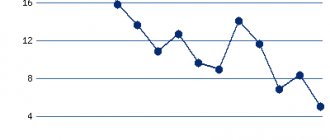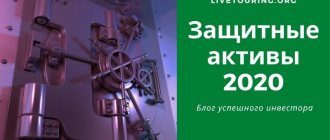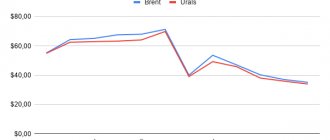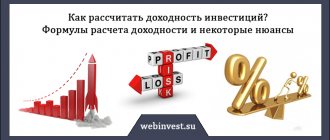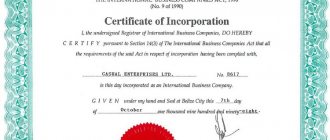10/17/2020 2 172 4 Reading time: 13 min. Rating:
Author
: Konstantin Bely
Today we’ll talk about how to save savings, how to protect savings from inflation and devaluation . In the recent crisis, such questions have become very relevant, I am often asked them, so I decided to write this article, which will include all the main answers. So, the most important thing on this topic is what will always be relevant, and in a crisis situation too.
Average inflation in Russia
To have an understanding of what to protect our capital from, we need information.
What was the rate of inflation in previous periods?
The Consumer Price Index or CPI will help us with this.
By the way, the very concept of inflation is a rather broad thing. This includes changes in prices for steam locomotives, machinery, yachts and palaces. It’s clear that ordinary citizens don’t care about this. Although the increase in prices for the above will directly affect our wallets, in the form of rising prices for consumer goods.
And this indicator tracks the consumer price index. But out of habit, we will simply call this matter inflation.
The average annual inflation for the last few years was:
- 15 years - 8.66%;
- 10 years - 7.3%;
- over 5 years - 7.28%.
We will dance from this data.
For those interested, the previous article presented inflation by year for all time. Plus a rather interesting graph of the decline in the purchasing power of the ruble over several years.
What to do? We need investment options that protect our savings from depreciation.
And now about what deflation is
Deflation is a process opposite to inflation and it manifests itself accordingly, on the contrary, in the growth of the purchasing power of the national currency. For ordinary citizens of the country who receive a stable salary, this is partly a profitable process, at least it seems so at first glance.
But for the country’s economy as a whole, deflation can mean a slowdown in economic growth and even the possibility of an economic crisis (which will certainly affect ordinary citizens). Therefore, from an economic point of view, moderate inflation is much more beneficial for the country than deflation. According to data for 2010, deflation was observed, for example, in Japan.
The term deflation comes from the Latin word deflatio, which means “deflation.”
Causes of deflation
- Decrease in the amount of money in circulation. This happens when people reduce their expenses and increase their savings. In addition, this situation may be due to the fact that the number of loans issued by banks is decreasing. In these cases, there is less money in circulation, which increases the demand for it and, accordingly, its value;
- Increased production volumes. Modernization and introduction of new technologies lead to an increase in production volumes. Which, while demand remains constant, is fraught with the fact that prices for these products will decline;
- A decrease in consumer demand, characterized by the fact that the population, expecting further price reductions, tends to postpone purchases for the future. A situation arises called in economics a “liquidity trap”;
- The government's tough economic policy aimed at combating inflation can also ultimately lead to deflation. The following measures are typically taken as part of this policy:
- The discount rate increases;
- The issuance of loans is limited;
- The sale of government securities is increasing;
- Taxes increase against the backdrop of a decrease in government spending, etc.
The consequences of deflation, or what impact it has on the economy
- A decrease in demand for goods and services occurs due to the fact that the population expects an even greater reduction in prices;
- A drop in production levels, explained by the fact that the demand for products has decreased significantly, and therefore there is a shortage of funds to cover production costs;
- Rising unemployment as a consequence of falling production levels;
- A decrease in wages due to the fact that companies are trying by all means to compensate for the lack of funds that arose due to the fall in demand for their products;
- A wave of enterprise bankruptcies in almost all areas of activity is associated, again, with a sharp decrease in demand for their products;
- Depreciation of many types of assets and outflow of investment, further exacerbating the above-mentioned consequences of deflation.
Minimizing the negative consequences of deflation
When the purchasing power of a country's population grows due to increased production rates and a general improvement in well-being, this is certainly a positive process. This is good for both the population and the economy of the country as a whole. But deflation, coupled with all the consequences described above, although it seems to increase the purchasing power of citizens, ultimately does not lead to any improvement in well-being. On the contrary, its consequences are a general decline in production and a crisis in the country's economy.
In order to minimize as much as possible the negative effects that deflation has on the economy, the following measures are usually taken:
- The lending sector is being stimulated, namely: the conditions for issuing loans are being simplified and interest rates are being reduced. The state is launching additional lending programs in close cooperation with the country's leading financial institutions;
- Easing tax policy allows reducing the burden on the country's enterprises in order to help them overcome the crisis of overproduction. The introduction of tax incentives for companies investing in infrastructure development and other government programs allows us to further strengthen measures taken to overcome the consequences of deflation;
- Large-scale construction projects are being launched, providing jobs to the population and orders to the country's enterprises. This could be the construction of roads, gas pipelines and other infrastructure facilities. In this way, production is stimulated, workers’ wages increase, and demand in the country’s domestic market increases.
Bank deposit
The most popular way. But is it the most profitable?
Keep your money in a savings account. If you have them, of course!
Georges Miloslavsky
Previously, it was enough to conduct a small analysis of bank offers. And choose the highest rates.
Now that banks are closing in batches, reliability comes first. I don’t want to run around later, waste my nerves and time in order to shake out my hard-earned money back. Yes, deposits are protected by the DIA. And it seems that the client does not lose anything.
In fact, this is a little different. Let's skip all the bureaucracy regarding the release of money from captivity.
The law clearly states that the client’s money is protected. But... people have a misunderstanding about interest on deposits.
You have opened a deposit. Valid for 1 year. Interest on the deposit is accrued at the end of the term. And if force majeure occurs (revocation of a license) during the validity period of the deposit, then you are guaranteed a return of only the body of the deposit. Interest has not yet been accrued. And the DIA will not return this part of the money to you. Go to the problem bank yourself and extract your profit from the owners (if you find them).
An option to get out of this situation is monthly or quarterly capitalization of interest. The money has appeared (credited), which means it is already insured.
What is our profitability?
If you choose only from the most reliable banks, then the interest rate is a little lame. You have to sacrifice profitability for reliability.
As a rule, banks offer deposits at a rate approximately equal to the inflation rate in the country.
The rate increase can be influenced by:
- amount of capital;
- deposit term.
The longer and longer, the higher the rate banks can offer clients.
Bottom line. Banks cope with their task of preserving funds from inflation. Maybe not 100%. But you will protect the lion's share of the depreciation of money. According to statistics, on average deposits lose to inflation by 0.5 - 1% per year.
What else needs to be done to protect your savings
If you have saved a large sum, diversify it. Let one part of the money be on your card with interest on the balance, the other in investments, the third in the bank, the fourth in your own business.
Diversification allows you to more effectively protect against inflation and at the same time worry less about the safety of capital. I have a separate article about diversification, where I tell you what it is like and how to do it correctly - take a look.
Bank cards as an alternative to deposits.
The most important advantage is that there is no need to freeze money for a long period of time.
Interest is charged on any amount. And you can withdraw them at will at any time.
The main thing when choosing a card is to look at the method of calculating interest. We need daily, for the current card balance.
For every day money drips. It is usually paid at the beginning of the next month.
The beauty is that the income will go to all your money at once. We received a salary. From the first day interest will accrue.
If you opened a deposit, you would need to leave some of the money “for living”. And here the means of subsistence bring some income.
Article on the topic: List of cards with interest on the balance
You will be surprised, but many cards charge interest no less than bank deposits. Although on average, slightly losing to them in terms of rates. But considering that the entire amount is at work, and not just the deferred one, you can earn even more from interest.
Conclusion. A good alternative to deposits. No freezing of funds for a long period of time. Money works completely everything. Billing is monthly. There is no minimum amount for interest to accrue. A good option is protection against inflation.
Investment companies and online tools
In the last 5–10 years, many investors have become seriously interested in the topic of online investment. For example, today online investment companies, PAMM account brokers and cryptocurrency are very popular - these tools make it possible to overcome inflation and earn profit. Thus, the same online investment projects, with a competent approach, allow you to earn from 5–10% profitability per month. Of course, this is associated with corresponding risks and these deposits need to be given much more attention than the same bank deposits. But the result in the end turns out appropriate. You can find more detailed information about investing in cryptocurrencies and online projects in the relevant sections of this site.
Dollars and euros
“The ruble exchange rate is unstable. Like constantly depreciating. And hard currencies are reliable. And one hundred percent protection against inflation. Nothing will happen to them."
This is exactly what most people think when buying dollars and euros. Less common are other currencies.
Is it profitable?
Let's think logically. You simply transfer savings from one currency to another.
And almost all currencies also have inflation.
For example, dollar inflation averages about 2% per year.
Considering the average annual growth of the CPI in Russia at 7-8%, exchanging for dollars allows you to immediately save money by 5-6% from depreciation.
The issue has been partially resolved. But is it always profitable?
Look at the ruble dollar chart.
Yes, we see overall growth. Only the main problem is when would you buy the currency? Perhaps at or near the peak. Then you would have suffered double losses. Due to the strengthening of the ruble exchange rate. And dollar inflation.
Conclusions. Buying dollars takes place only for long periods (if you are willing to put up with slight dollar inflation). For short periods, protecting money from depreciation in this way will not give one hundred percent results.
We make passive investments
I will tell you about the main types of passive investments and comment on each type. Let me note right away that I will include bank deposits here, although not all economists consider a bank deposit to be an investment.
Card with interest on balance
Modern banks issue not just debit cards, but cards with interest on the balance. This is the simplest and most convenient way to protect against inflation.
This is how cards work. You place a certain amount of money on them, the bank checks daily how much is on the card and charges interest on it daily. At the end of the month, the total accumulated amount is credited to the account.
If I have 200,000 rubles on my card at 5 percent per annum, then I will receive approximately 0.0136 percent per day for this amount. If I have this money on my card for ten days, then I withdraw it for ten days, and then put it back in for another ten, then the interest will accrue for a total of 20 days of the month. And in the end I will receive 547.9 rubles.
Advantages of cards with interest on balance:
- Money can be transferred to the card and completely withdrawn from it at any time. You can go to an ATM at any time and withdraw absolutely everything from your card. And you won’t have to write any papers, statements about closing the account - nothing at all. They put it in and took it off.
- Daily percentage. Interest is calculated every day, so if I withdraw all or most of the amount for a day and then deposit it again, I will only lose interest for one day. For all other days interest will be accrued.
- They can be used to pay in stores.
I myself use a Tinkoff Black debit card with interest on the balance. I transfer all my income from freelancing to it, and I pay with the same card in supermarkets and even small shops. The card is multi-currency, so I can keep money on it in rubles, dollars and euros at the same time, take it with me on a trip, and pay with it abroad.
Here is our article about the Tinkoff Black card - read it.
Such cards, of course, won’t bring you a lot of money. But they can definitely protect against inflation (at least official).
Another plus is that the card earns compound interest. That is, the bank credited me 547 rubles - next month the interest will no longer be on 200,000, but on 200,547 rubles.
Bank deposit
A deposit in a bank has its pros and cons. The advantage is that interest rates on deposits are higher than rates on cards. For example, a bank may have not three percent, but five or six.
But withdrawing money from a bank is usually much more difficult than withdrawing money from a card. Many banks generally freeze depositors’ money for a predetermined period - six months, a year, two years, and so on. During this time, you cannot withdraw money. And if you do withdraw them, all the interest will be lost.
Money can be placed in a bank account if you do not know how to invest, cannot find a more profitable use for the money, and are sure that you will not need this money during the deposit period.
Individual investment account
Few people have heard of this instrument, but nevertheless the thing is very cool and profitable.
An individual investment account, or IIA, is an investment account. Investors place money on it in order to invest it in various financial instruments, most often in securities - stocks and bonds.
However, you can make money on IIS not so much through investments as through deductions. For example, if you work as an individual and pay income tax on your salary, you can take advantage of the Category A deduction once.
It goes like this. You deposit a certain amount of money into an IIS, and then request an amount equal to 13% from it. For example, if I put two hundred thousand on IIS, 13% of them will be 26,000 rubles. If I paid 26,000 in taxes in a year, then the state will return these taxes to me.
The maximum amount that can be received under deduction A is 52,000 rubles. In order to “earn” it, you need to deposit 400,000 rubles into the IIS for the entire period of its “life”.
Is it necessary to make investments with IIS? Well, in general, yes, otherwise the tax authorities will understand that you opened an IIS only for the sake of deductions. But you can make very small investments of a couple of thousand rubles - for example, buy several government bonds (the most reliable investment instruments of all existing ones).
IIS has its limitations. In particular, it opens for at least three years. If you close your account early, you will not see any deductions.
Here is my detailed article about an individual investment account, where I tried to describe in detail and clearly all the intricacies of its work. Read carefully and take notes.
Bonds
Bonds are a type of securities for which the return (coupon) is known in advance. When you buy a bond, you are essentially lending your money to the company.
The interest on this category of securities is higher than on a bank deposit. However, bonds, unlike bank deposits, are not insured. Although, in most cases, investments in bonds pay off because, even if a company goes bankrupt, its debt obligations and bonds are paid off first.
To make a lot of money in bonds, you need to do the following:
- Invest in proven companies. For example, blue chips. In the Russian Federation, blue chips include companies like Sberbank and Gazprom. These are reliable ones that feel very confident and are guaranteed to make all the proper payments on the bonds.
- Invest through IIS. Then you can earn extra money on tax deductions.
By the way, you can invest money in bonds issued by the state. They are called OFZ - federal loan bonds. This is probably the most reliable tool for investing and protecting money from inflation. You will not receive income from OFZs only if the state goes bankrupt.
Here is a link to my article about bonds - I talk in more detail about this financial instrument and the intricacies of investing in bonds. Check it out.
Real estate
If you have enough money to buy real estate, then you can invest your capital “in the walls” to be guaranteed to save it from inflation. Real estate can only depreciate greatly if there is a war or a global economic catastrophe.
However, there are a few important points to keep in mind:
- The price of an apartment in a new building drops immediately after you start living there. Therefore, investing in a completely new property can only be profitable if you are prepared not to sell this property for several decades.
- If major changes occur in the infrastructure of a community, the price of your property may drop significantly. For example, if a new road is laid in a “dormitory” area or a factory is built, the area ceases to be a “dormitory”.
- Real estate needs to be monitored. Your neighbors may flood you, something may happen to your heating, etc. But I generally keep quiet about private houses, there are a lot of problems there.
- You have to pay for real estate. Taxes, utility bills, payment for major repairs. If you yourself do not plan to live in the purchased property, think three times before buying it.
And another problem is the neighbors. This is especially true for apartments. Music, conversations, stomping feet, screaming children, repairs, piano and electric guitar, scandals and quarrels - the list goes on and on.
Real estate can be a major source of headaches, keep that in mind.
Real estate
You understand, the main disadvantage is that you need a LOT of money.
Regarding protection against inflation, statistics will show better than any words. What happened in the mid-2000s (explosive growth in housing) is rather nonsense.
All over the world, houses and apartments are rising in price at approximately the rate of inflation (plus or minus a couple of percent).
Buying an apartment in the hope of further growth is unpredictable. Even an ordinary simple apartment is expensive for the owner. Payments for housing and communal services are rising. A small plus will be the possible rental. But here, too, the grandmother said in two.
For some landlords, the hair stands on end after tenants move out. Pump up money for repairs again. And it turns out that it would be cheaper not to rent out the apartment.
What does inflation mean?
The inflation rate averages the increase in prices of individual products or services, so it is not always clear where the indicator comes from. The cost of some products is growing faster, while in other groups of goods prices are falling.
In conditions of free economic relations, it is impossible to establish uniform indicators of price increases or decreases. If bread has risen in price by 10% , and potatoes have become cheaper by 5% , the average inflation will be from minus 5 to plus 10 percent. In good years, potatoes are cheaper or rise in price slightly. If there was a bad harvest, you should expect a price jump.
Uncontrolled inflation can lead to a shortage of earned money to purchase a set of essential products and services. If it is difficult to directly influence the relationship between supply and demand, then the Central Bank (or the Bank of Russia) can adjust the movement of money. The ongoing monetary policy reduces or increases the inflation rate, depending on the plans and intentions of the Central Bank. It is not necessary for prices to constantly rise. Inflation should not interfere with the development of all sectors of the economy.
Real estate funds
You could say real estate investment alternatives for the poor.
What is it and where to buy?
We will not talk about Russian real estate mutual funds. In my opinion, the scheme is murky. They are completely opaque. They have a high entry threshold. And as one acquaintance who moves in that environment told me, if you are not close to the top of the owners, you will be 100% hired or deceived (whichever you prefer).
Abroad in this regard it is better.
There are Reits that invest in real estate. Mainly commercial. And they rent it out. In short, everything is done for you.
And they pay dividends to their shareholders. Every quarter. By law they must pay out 90-95% of profits.
This gives a yield of around 5-8% per annum. In dollars.
Plus, real estate grows over time. At least at the inflation rate.
Not bad? I think yes!
Where can I buy this and how much does it cost?
The cost of one share is within one to two hundred dollars.
The main inconvenience is that to purchase, you need access to foreign markets. Through a foreign broker.
Conclusion. The funds cope with inflation protection. The expected profit is even higher. It is recommended to invest for long periods. From 3 years.
Cons: From time to time, real estate prices may decline.
Purchase and sale of OFZ-IN
Apart from the indexed par value, this bond is no different from standard OFZs with a fixed coupon. The price on the market may differ from the face value in one direction or another. Now all bonds of the 52nd series are trading above par.
When purchasing a bond, you must pay the previous owner the accrued but not yet paid coupon (accumulated coupon income - ACI). When you sell, accordingly, you will already receive the NKD.
Transactions with OFZ-IN bonds are carried out on the Moscow Exchange and are available to all categories of investors. The main thing is that you have a brokerage account.
OFZ-IN income consists of coupon income and the difference between the sale or redemption price and the purchase price. On both of these incomes you need to pay personal income tax in the amount of 13%, which your broker will be happy to do for you.
Gold and other metals
Invest in despicable metal. What could be more profitable? Gold is always rising in price. Etc.
Factors for:
- Gold is a physical commodity. And a priori, with a general rise in prices (inflation), it should become more expensive.
- Gold is insurance against wars, shocks, crises and wars. Whenever something like this happens, gold prices go up.
- Gold on world markets is quoted in dollars. When the national currency weakens, the ruble value of gold increases.
Recommend: How and where is it better to buy gold
And now the cons:
- The gold rate is subject to fluctuations. Both up and down.
- In some cases, when investing in gold, you will have to incur expenses (commissions - one-time and permanent, plus taxes).
Conclusion. The likelihood of saving savings from the effects of inflation increases as the investment period increases. Optimally - from 3-5 years.
Living conditions and your education
It is advisable to always improve your living conditions as much as possible.
If you live in an environmentally polluted environment, then you should think about moving to another cleaner and more suitable place. It is a good idea to purchase only high-quality and durable items - from furniture and clothing to healthy food. Don't be afraid to invest in improving living conditions. People who pay attention to their surroundings and spare no expense on their health (timely treatment, medications, recreation, sports) rarely complain about life and live longer. How to effectively combat inflation? Invest in your education. Always try to develop in your chosen profession and beyond. As they say, the best option for investing money is investing in yourself. Study in your field of activity, learn foreign languages, take a driver's license, etc. Versatile people have a significant advantage in the modern labor market.
Bonds
Bond yields on average provide a benefit of 2-3% above inflation.
The interest rate on the coupon will depend on the reliability of the issuer, the duration of circulation of the paper and the type of coupons accrued.
For the uninitiated, it’s a little tedious and incomprehensible (in fact, it’s really easy to figure it out from scratch). What is a coupon yield and what does it depend on, how the nominal value differs from the market value, offer, default, reliability and classification of the issuer and many other scary words.
In fact, it's not all that scary. Read a couple of articles and you will understand the general meaning: what, where and how. You can start with this - 10 questions about bonds!
The easiest way to save money from the effects of inflation is to buy bonds with an indexed par value. The main goal is protection against inflation.
Owners always receive a return of 2.5% above inflation.
If inflation in the country is 10% per year, you will earn 12.5% profit. It will be 50 - your profit is 52.5%.
In what directions should we act?
To successfully combat inflation, it is necessary to act comprehensively in two directions:
- 1.
Take urgent anti-inflationary measures. - 2.
Take a strategic course to strengthen the state’s economy.
The essence of this method is simple - urgent measures will reduce the rate of inflation growth, and a strong economy will be able to effectively withstand future inflationary attacks on the state. Want to know what exactly needs to be done? No problem! Let's start with the first point - urgent anti-inflationary measures.
Eurobonds
The same bonds, only denominated in dollars. They give a return of 3-5% per year. Naturally in foreign currency.
Otherwise, they have similar properties compared to ordinary bonds.
1 Eurobond costs from 1 dollar. There are papers for 10 and 100 thousand apiece.
Read about Eurobonds:
- Why are Eurobonds useful?
- How and where it is profitable to buy Eurobonds.
Conclusion. In principle, debt securities (ruble and dollar) quite cope with the task of protecting against the depreciation of money. Suitable for short and long periods.
Strategic methods to combat inflation
Rising inflation rates indicate the vulnerability of the country's economy. The solution to the problem suggests itself - we urgently need to strengthen the economy. Strategic methods to combat inflation will help with this:
- Achieving inflation targets.
During a crisis, the state is obliged to take control of the situation as soon as possible. And the first thing that needs to be done is to return financial guidelines to business and the population. To do this, it is necessary to provide timely and accurate information on real and planned inflation rates for the current year. This will speed up economic recovery processes and strengthen public confidence in the authorities. However, one must understand that: Inflation targets must be truthful. Otherwise, the authorities will completely lose confidence in themselves, and the country will be overwhelmed by another wave of crisis. - Changes in budget policy.
The decline of the economy leads to a shortage of money in the state budget. The issue of fiat money supply will not solve the problem - it will only start the process of depreciation of money, and inflation will continue to rise. Alternatively, you can turn to countries with stronger economies for financial assistance, but this is a path to debt. Therefore, it is necessary, first of all, to reconsider the state’s budget policy - to reduce expenses and increase budget revenues. For example, freeze the financing of unpromising projects, reduce the bloated state apparatus, carry out a structural restructuring of production, ensure the receipt of tax payments in full, etc. - Creating comfortable conditions for business development.
Entrepreneurs are a powerful driving force capable of resuscitating the economy and leading the country out of the crisis. What need to do? At a minimum, simply do not interfere with their work, and at a maximum, create a favorable environment for the development of small and medium-sized businesses (support at the legislative level, elimination of bureaucratic barriers, fight against corruption, moderate taxation, etc.). - The course towards import substitution.
Particular attention should be paid to the development of our own manufacturing enterprises - they are the ones who produce GDP, and they are the ones who reduce the country’s dependence on imports. And the smaller this dependence, the more resistant the economy is to external shocks.
So we looked at the main methods of combating inflation. At first glance, they seem simple and understandable, but implementing them in practice can be quite difficult. However, nothing is impossible in our life! The main thing is to never give up!
So, friends, this concludes the series of articles on inflation. We hope they were informative and useful. Stay with the portal temabiz.com – it’s interesting here!
Our groups:
Stock
By buying shares, you get a piece of the business. It may be small (most likely a billionth part), but it is there. And you have the right to all the goodies that more established investors who own shares worth tens or hundreds of millions have.
A company is a business. As it grows, capitalization or share price increases. Plus, many companies pay shareholders part of their profits in the form of dividends.
In some companies (I won't say that in many), even one dividend flow exceeds inflation. For example, metallurgists (NLMK, MMK, Severstal, NorNickel) pay more than 10% per year in the form of dividends. Not to mention the constant growth of shares on the stock exchange.
For future shareholders: How to buy shares as an individual and receive dividends
With inflation, everything goes up in price. And the company's assets are no exception. If everything in the country has increased in price, a priori business will also become more expensive. At least at the inflation rate.
Is everything too smooth? There must be some kind of catch.
Shares can not only rise in price, but also... fall. And very, very significant. Over the course of a year, it’s easily 20-30%.
And you need to invest only in companies with good and stable business. And here's the problem. How to find out?
As Comrade Lenin said: “Study, Study and Study again.”
Fuck it... How long does it take? A few months for sure!
An alternative (and most correct) option would be to purchase all the largest companies at once.
In this case, we get rid of the need to analyze each company separately. We hire only the best. And our profitability indicator will be the average among all of them.
How much can you earn from this? And how to buy all companies at once? Perhaps you need a lot of money?
- You can count on an average return of around 4-6% per year. BEYOND INFLATION. But this rule only applies for long periods (minimum 5 years, ideally 10).
- You can buy companies as part of an ETF (collective investment fund). For example, ETFs for Russian stocks include 42 largest companies (Gazprom, Sberbank, Lukoil, MTS, Magnit, Yandex and many other well-known and unknown words).
- The cost of one ETF is within several thousand rubles.
And now the cons...
- High risks. No one guarantees profit. The stock market may decline. And not just for one year. And two or three in a row.
- It is strictly not recommended to invest money in stocks for short periods. If your goal is 2-3 years, forget about this option.
Conclusions. Suitable only for very long-term investments. We have a high potential return that exceeds inflation. As the investment horizon increases, the risks decrease.
Protecting money from inflation
To reduce the severity of the consequences of high inflation rates, citizens make efforts to protect the value of money:
- Registration of an investment portfolio on the terms of long-term, diversification, with the right to manage in a crisis situation. A person seeks to invest money in various investment products and economic areas in order to ensure the sustainability of the investment.
- Buyer interest is shifting in favor of precious metals, long-term products, and hydrocarbons. The method is to purchase raw materials through commodity exchanges, where prices change even faster than stock quotes. This option is designed for trained citizens who understand the specifics of this area.
- Purchasing real estate with real value. Investments in real estate in the long term are more likely to pay off, if not through price increases, then through rent.
Why buy OFZ-IN?
OFZ-IN is insurance against inflation risks.
The higher the price level, the higher the denomination of the bond, therefore, the higher the coupons. At the same time, OFZs have high reliability, guaranteed by the state and high market liquidity
The risks of investing in OFZ-IN include the fact that their profitability grows at the rate of official inflation, which does not always reflect the real depreciation of money.
For advanced investors, to work more effectively with OFZs, it is necessary to compare “2.5% + official inflation” (and the prospects for this indicator) with the current yield of OFZs with fixed payments. It is also worth considering the difference in prices for standard OFZ and OFZ-IN. For small capital and novice investors, the gain will be insignificant, so they can safely replace OFZ with OFZ-IN with a suitable maturity.

